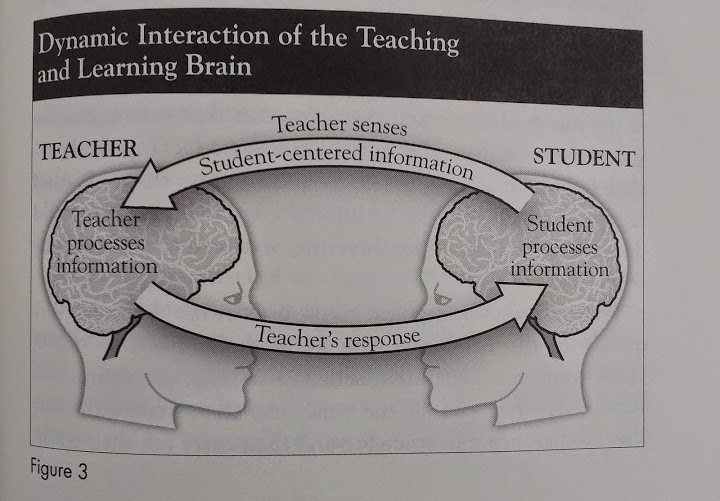The Teaching Brain: Changing the Field of Education
Never ever ever ever do you, as a teacher, want to stop learning. It influences the newness of your approach, which influences the receptivity of your students and makes them as excited as you are.
So notes The Teaching Brain: An Evolutionary Trait at the Heart of Education. Researched and written by Vanessa Rodriguez with Michelle Fitzpatrick, this book is a game-changer for the field of education, and a must-read for any educator. Rodriguez is an advanced doctoral candidate and instructor of Education at the Harvard Graduate School of Education, where her research has been recognized for its innovation and potential impact on education with the prestigious Harvard Initiative for Learning and Teaching (HILT) Award.

Let me tell you about The Teaching Brain. I picked it up, and couldn't put it down. It delves deep into how teachers teach - and provides an interactive model for teaching - and learning. The process of teaching isn't simple - there are myriad factors we need to think of - and there are a plethora of teaching models that have been promoted over the years. And yet, there has still been something missing, a common-sense approach to teaching the same way we live our lives - thoughtfully, interactively, developmentally, and with purpose. And this book - this exciting research - is that piece of the puzzle that has been missing.
And once you read this book? It will stay with you, influence how you teach, parent, and live, and change your students' lives.
Big claims, I hear muttered on the wind. But yes - this book backs it up. Far from the wide reading teachers have done on research on teaching, learning styles, and practice, The Teaching Brain moves past those and onto new ground:
The teaching brain framework allows us to explore teaching along the life span, from birth through adulthood, and enables us to embrace a holistic view of teaching...Though on the surface this seems contrary to a student-centered approach, in fact it offers a more comprehensive approach to student success - an approach that allows for everyone to win.
Instead of a one-size-fits-all teaching approach, which assumes that all learners are the same, the teaching brain model acknowledges the need to understand both the teacher and the student as well as their context and interaction.
FINALLY, finally, a teaching approach that follows closely to what educators (and parents) feel - that each student is different, that we need to adapt our ways of teaching to best serve each person, and that teachers, themselves, are part of the learning process.
Take a look at this diagram from the book that exemplifies what the teaching brain is about:

The teaching brain takes an interactive approach to teaching - and learning. The teacher has five awarenesses of the teaching brain (awareness of interaction, awareness of learner, awareness of teaching practice, awareness of self as teacher, and awareness of context). Look how the teacher interacts with the student - both taking in, and giving back - in a learned, motivating, dynamic way. As educators work on their awareness of these five areas, their teaching interactions with students will become more useful, giving a learning synchrony that is important to student learning and development. But here's the genius part - the teacher learns, too. Of course!
What is teaching? It's a way of sharing knowledge - and everyone does it, from small children to parents to everyone we meet, really.
What makes a teacher a teacher? It's the way in which the teacher utilizes their knowledge, skills, experience, and brain to reach their students.
The Teaching Brain crosses the abyss of standards and testing and delivers a common sense way of teaching as connecting with our students, of learning and growing together, of guiding and helping our students in a synchronous way. It provides a global solution to many of the problems besetting education around the world today. It will change the field of education. It's genius, and I highly recommend it. This is the best book on education I've ever read.
We were lucky enough to catch up with Rodriguez, and ask her about the book, inspiration, theories of teaching, and more. Here's what she had to say...

Please tell us about your new book, The Teaching Brain...
The Teaching Brain challenges widely accepted theories of teaching and offers a unique idea based on a simple yet empowering truth: we are all teachers. This book draws on the science of human development to redefine teaching as a social cognitive skill that develops in all people over time. The book marshals a wealth of research and experience to construct an entirely innovative framework for thinking about, talking about, and supporting this essential social endeavor.
What inspired you to write this book?
I spent over a decade in a classroom trying to defend my teaching decisions. I often found that the language I was using was not what administrators, researchers, and policy makers felt was appropriate evidence. I thought that a doctoral degree would help me to do this.
What I found instead was that we don't have an understanding of teaching as we do learning – we don't understand the natural development of teaching in all humans. It suddenly made perfect sense to me that for all of those years I struggled to describe my teaching because we have a very limited vocabulary and overall framework for what it is! I wanted to open the door to a new way of defining teaching.
Much of the field of teaching revolves around different theories of teaching, and yet your book is, by far, the best one I've read that takes into account real life interactions - and the growth of teachers. Can you give us a few examples as to how you developed your theory?
It's hard to identify a specific example within the development of this theory since this theory is just how I see the world. Teaching is a human interaction. Any time something involves an interaction with another human you have to take into account the complex nature of the brain. Our brains are complex, dynamic systems. Because they are dependent on our personal context, they are forever changing.
I would also note that most theories of teaching are actually stemming from theories of learning which is why they don't account for real life interactions or the growth of teachers. They are learner-centric and not about how humans teach but how humans learn. My theory is specifically about how we all develop our ability to teach.
A few memorable examples of how the distinction became obvious...
· When I first watched Waiting for Superman, I recall the cartoon visual they used to show knowledge being poured into a student's brain. I recall thinking to myself....this is not how any human brain works. We can't ever pour knowledge into the brain and expect learning to happen. So then why do we believe that we can pour knowledge about learning into a teacher's brain and say, "ok now go teach better."
· One day, I was sitting in a class lecture at Harvard when the professor showed the visual of a tornado and explained that the complex pattern of how a tornado develops is more in line with how the brain learns. He then went on to talk about chaos emergence theory....basically the idea that what seems like chaos is actually a very complex pattern of many variables coming together and the context matters. We seem to understand this when discussing weather and more recently we understand it when talking about learning and the brain. Well, I thought, teaching is about multiple brains coming together and interacting. If one brain is the complex equivalent of a tornado could you imagine what teaching looks like!
Part of the difficulty that teachers have in working with students is intercultural differences, which this book seems to encompass as a whole. What particular suggestions do you have for teachers who work with intercultural populations?
The Teaching Brain is about how we define teaching and understand it as a framework for our growth and interaction with learners. All interactions are about understanding your "self" so that you can better form theories of who your learners are. In the book, I specifically talk about having an Awareness of Self as a Teacher and an Awareness of Learner.
For teachers, working with intercultural populations this means recognizing their own assumptions about the varied cultures of the learners they are working with. It also means being extremely transparent about the values within their personal culture. Supporting a student without imposing our own cultural values is a very difficult task to manage but goes a long way in supporting the learner's development.
Why should teachers read this book?
We are all teachers from as early as age one we have the ability to teach and we teach without any prompting. However, we've never considered why we naturally teach nor how that natural ability shifts when we teach in the artificial setting of a classroom. By understanding the natural development of teaching, you'll become enlightened on your personal development. Rather than being told how to teach based on a one-size-fits-all approach, you can discover your own teaching awarenesses; and therefore how you can more effectively interact with your learners.
What's up next for you?
The book highlights the overall theory I've developed on teaching but there's actually a side of my research that it doesn't delve into much. I'm currently designing and conducting studies to further understand the development of how humans teach. In the fall, I'll be looking at teachers and students brain activity as they interact. I hypothesize that when they feel like the interaction has been successful, we'll likely see their patterns of brain activity synchronize. So rather than just saying "when it's working you can feel it," we'll actually be able to say you can also see our brain activity synchronize and act as a cohesive system rather than individual parts!
Is there anything else you'd like to share?
One of the most significant aspects of my learning on teaching has been my travel experiences. Typically, I make a point of traveling at minimum three times a year out of the U.S.. As a practicing public school teacher, this was not an easy feat! What always strikes me when I travel is that no country teaches in exactly the same way. There is no such thing a "best practices" that is true for every part of the world. Each country teaches in a way that serves their cultural needs for better or worse. Therefore, rather than arguing over who does it right, why not begin with the common denominator – we are all humans. If we understand how our mind/brain develops, the ability to teach then we can use that as a ruler to find best fit rather than best practices.
Author photo courtesy and copyright Vanessa Rodriguez
Note: This article was originally published in 2015 and updated in 2017




















